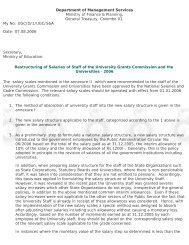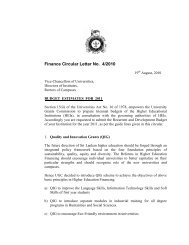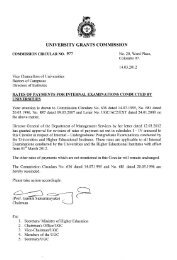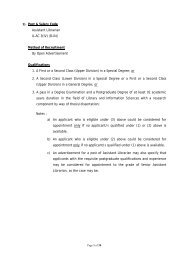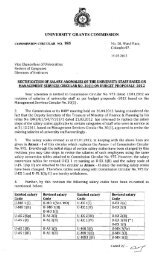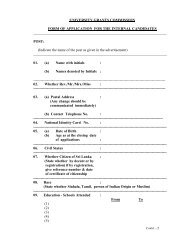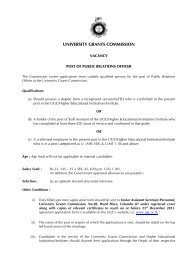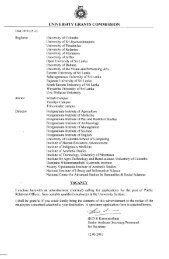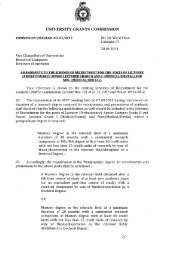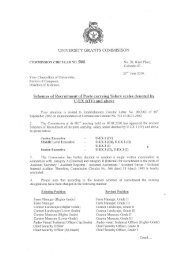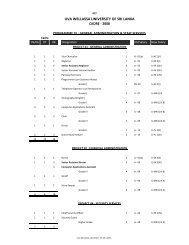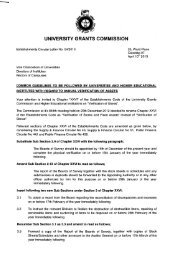- Page 3 and 4:
Rebuilding of Tsunami Affected Area
- Page 5 and 6:
I L.M. Abeywickrama A.N. Ahmed Goub
- Page 7 and 8:
S. Krishanthan Department of Physic
- Page 9:
P. Vinobaba Department of Zoology,
- Page 12 and 13:
VIII safety; (iv) enhanced inter-cu
- Page 15 and 16:
XI TABLE OF CONTENTS List of Contri
- Page 17:
I. INTRODUCTION AND OVERVIEW
- Page 20 and 21:
2 economic activity in the affected
- Page 22 and 23:
4 participation in thespecific tsun
- Page 24 and 25:
6 The purpose of the adaptive manag
- Page 26 and 27:
8 The personnel from the Universiti
- Page 29 and 30:
SUSTAINABLE RURAL LIVELIHOODS AS A
- Page 31 and 32:
13 CVA could direct development aid
- Page 33 and 34:
Thus there has been a steady increa
- Page 35 and 36:
ecause mediating processes between
- Page 37 and 38:
19 Conclusion The SRL approach from
- Page 39:
Scoones, I. (2009). Livelihoods per
- Page 43 and 44:
ADAPTIVE SYSTEM FOR THE PREDICTION
- Page 45 and 46: 27 Table 2.1: Hazards relevant to e
- Page 47 and 48: 29 Indigenous In the ancient days,
- Page 49 and 50: 31 notify to the administrator abou
- Page 51: 33 Bibliography Motogi Ikeya, Tomon
- Page 54 and 55: 36 Introduction World disaster data
- Page 56 and 57: 38 The main objectives of the prese
- Page 58 and 59: 40 Figure 2.9: 2004 Tsunami inundat
- Page 60 and 61: 42 The direction boards (Fig.2.11)
- Page 62 and 63: 44 the people, etc to convert the s
- Page 64 and 65: 46 Conclusion Physical survey and v
- Page 66 and 67: 48 World Disasters Report 2005, Int
- Page 68 and 69: 50 Figure 2.19: Impact of Tsunami i
- Page 70 and 71: 52 Figure 2.20: Evacuation plan: Ma
- Page 72 and 73: 54 Renovation of Tsunami and multi
- Page 75 and 76: INTERVENTION OF CIDA RESTORE PROJEC
- Page 77 and 78: 59 Figure 2.25: Palameenmadu area F
- Page 79 and 80: 61 The table 2.4 shows the ranges o
- Page 81: 63 Strengthening of wells Ten and s
- Page 84 and 85: 66 Introduction Natural disasters a
- Page 86 and 87: 68 before the disaster. By contrast
- Page 88 and 89: 70 Figure 2.28 shows rearing method
- Page 90 and 91: 72 Nikonov, A.A. (1991). Abnormal a
- Page 93 and 94: A REMEDY FOR THE PROBLEMS CAUSED BY
- Page 95: 77 Figure 3.2: Blocked drainage and
- Page 99 and 100: 81 Figure 3.6:Sieving the compost F
- Page 101 and 102: GROUNDWATER DISTRIBUTION IN THE GAN
- Page 103 and 104: 85 In general, the aquifer consists
- Page 105 and 106: 87 chordMOW (Matara Observation Wel
- Page 107 and 108: 89 Table 3.5: Criteria adopted for
- Page 109 and 110: 91 Figure 3.14: pH distribution map
- Page 111 and 112: 93 Figure 3.16: Water table in 3D d
- Page 113 and 114: 95 A B Figure 3.18: Groundwater sal
- Page 115 and 116: 97 Conclusions and Recommendations
- Page 117 and 118: PRODUCING LIGHTWEIGHT CONCRETE USIN
- Page 119 and 120: 101 Table 3.7: Chemical composition
- Page 121 and 122: 103 Table 3.10: Mixtures used in th
- Page 123 and 124: 105 0.6 Graph for Sample No Vs Comp
- Page 125 and 126: 107 The material used in this rese
- Page 127 and 128: IV. ENVIRONMENTAL RESTORATION 109
- Page 129 and 130: REHABILITATION OF MANGROVES IN PAAL
- Page 131 and 132: 113 Present biodiversity in both vi
- Page 133 and 134: 115 Figure 4.1: Satellite images sh
- Page 135 and 136: 117 Table 4.1: Extent of mangrove i
- Page 137 and 138: 119 lagoon for mangrove re-planting
- Page 139 and 140: 121 Multifaceted approach in mangro
- Page 141 and 142: 123 5. Re-vegetation of mangroves T
- Page 143 and 144: 125 Hogarth, P.J. (1999). The Biolo
- Page 145 and 146: MILK FISH FARMING IN CAGES TO ENHAN
- Page 147 and 148:
129 Within aquaculture production s
- Page 149 and 150:
131 Floating cages were constructed
- Page 151 and 152:
133 Figure 4.8: Changes of Average
- Page 153 and 154:
135 This method is cost effective,
- Page 155 and 156:
137 serious health risk to people c
- Page 157 and 158:
M.F. Nawas A SIMPLIFIED APPROACH TO
- Page 159 and 160:
141 Although, all the components of
- Page 161 and 162:
143 Aniline 0.97 Benzene-1,3-diamin
- Page 163 and 164:
145 Bibliography Al-Degs, Y., Khrai
- Page 165 and 166:
147 SUSTAINABILITY OF COMMUNITY BAS
- Page 167 and 168:
149 that the community through its
- Page 169 and 170:
151 values for willingness to pay f
- Page 171 and 172:
153 1 st STEP 2 nd STEP 3 rd STEP I
- Page 173 and 174:
155 39% 48% 0% 7% 6% Kitchen wastes
- Page 175 and 176:
157 Table 4.11 shows the results of
- Page 177 and 178:
159 technologies of composting and
- Page 179 and 180:
161 Tandom, H.L.S. (1994). Recyclin
- Page 181 and 182:
COST BENEFIT ANALYSIS OF NOVEL FISH
- Page 183 and 184:
165 Drier was introduced to a selec
- Page 185 and 186:
167 The project: how does this init
- Page 187 and 188:
169 business was inaugurated. Figur
- Page 189 and 190:
171 goraka, fire wood, packeting ma
- Page 191 and 192:
173 the drier. Table 4.13 proves a
- Page 193 and 194:
175 the fisheries industry in the p
- Page 195 and 196:
V. GENDER ISSUES AND SOCIAL HARMONY
- Page 197 and 198:
THE BEREFT WOMEN OF THE EAST: MICRO
- Page 199 and 200:
181 Table 5.4: Education level of w
- Page 201 and 202:
183 Madinah is 49 years old. Her hu
- Page 203 and 204:
GROUP FORMATION AND SOCIAL HARMONY:
- Page 205 and 206:
187 Methodology The researchers rec
- Page 207 and 208:
189 2. The definition of community
- Page 209 and 210:
191 4. Strengthening the funding in
- Page 211 and 212:
A GENDER PERSPECTIVE ON TSUNAMI RES
- Page 213 and 214:
195 Strategic gender needs Addressi
- Page 215 and 216:
197 Although men are the main bread
- Page 217 and 218:
199 Mallawaarachchi, R.S. and Jayas
- Page 219 and 220:
PERCEPTIONS AND REALITIES: WOMEN’
- Page 221 and 222:
203 Among the three stories, the fi
- Page 223 and 224:
205 Bibliography Ariyabandu, M. and
- Page 225 and 226:
IMPACT ON SELECTED SKILL DEVELOPMEN
- Page 227 and 228:
209 programmes and strategies which
- Page 229 and 230:
211 Regarding the result of the stu
- Page 231 and 232:
VI. LIVELIHOOD RESTORATION ACTIVITI
- Page 233 and 234:
HOME GARDENING AS A TOOL FOR IMPROV
- Page 235 and 236:
191 Methodology Study area descript
- Page 237 and 238:
193 Figure 6.3: Land size distribut
- Page 239 and 240:
195 WHO Technical Report Series-797
- Page 241 and 242:
CRAB FATTENING IN WOODEN CAGES AND
- Page 243 and 244:
199 Sheltered bays and mangrove are
- Page 245 and 246:
201 Among the 20, five cages were s
- Page 247 and 248:
203 Figure 6.6: The growth performa
- Page 249 and 250:
205 enough to establish another cag
- Page 251 and 252:
207 Samarasinghe, R.P. and Fernando
- Page 253 and 254:
BIOGAS AS AN APPROPRIATE TECHNOLOGY
- Page 255 and 256:
211 Matara District, by way of cond
- Page 257 and 258:
213 digester The fresh cow dung req
- Page 259 and 260:
215 Figure 6.13: Pesticide free roo
- Page 261 and 262:
217 7000 6000 5000 Income Rs. 4000
- Page 263 and 264:
219 Conclusion The biogas technolog
- Page 265 and 266:
VII. LESSONS LEARNED 221
- Page 267 and 268:
COMMON CHALLENGES IN POST DISASTER
- Page 269 and 270:
225 It’s necessary for any organi
- Page 271 and 272:
227 influence in the recovery activ
- Page 273 and 274:
LESSONS LEARNED FROM THE RESTORE TS
- Page 275 and 276:
231 project suggests that once the
- Page 277 and 278:
233 Politics It would be healthy if
- Page 279 and 280:
235 AUTHOR INDEX Abe, .............
- Page 281 and 282:
237 Gündüz, L., .................
- Page 283 and 284:
239 Postacıoğlu, B., ............
- Page 285 and 286:
241 Yağanoğlu, A.V., ............



